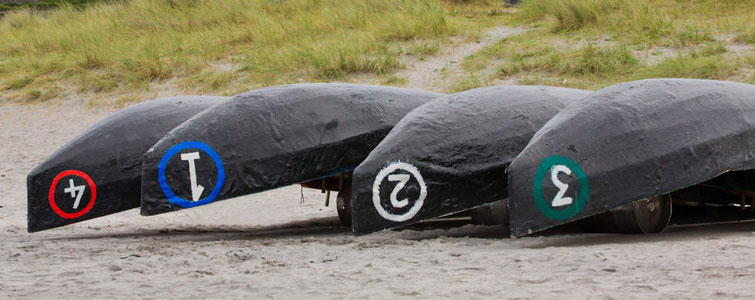Currachs in County Mayo

Mayo has a very long coastline and for this reason fishing was the lifeline, for many centuries, of those living around the coast. Fishermen in small boats, called currachs, braved the rough and dangerous Atlantic seas to catch the fish so vital to their daily food.
Currachs, symbol of the romantic west coast and featured in many films, were essential for the tough fishermen and for the villages’ sustenance on the coastline and islands alike. In bygone days they were used for fishing, for bringing goods and livestock, including sheep and cattle, from the mainland and goods from the island to the mainland and were the only connection to the mainland.
The building of currachs needed traditional skills and crafts passed down through the generations. The frame consisted of lats or hoops of timber, over which animal skins or tarred canvas were stretched. Holes were bored in the gunnel for tholepins into which oars fitted. Usually five men could rowed currachs.
In South Mayo the bottom and sides were covered with a thin planking. On Achill Island curraghs were built with double gunwales. The Inishturk Currach has been used for the last 100 years and was of a wooden lattice and plank construction with a calico and tarred outer lining for water proofing. It was traditionally rowed by three men.
Returning from fishing currachs were carried to a currach pen where they were upturned and anchored down. The rectangular shaped currach pens were made up of beach pebbles and local stones. They can still be seen at north-east of Dooagh Pier and Purteen Harbour on Achill Island.
Along the Mayo’s coast many places take their names from the word currach such as “Portion na gCurrach” (the small harbour of the curraghs) or “An Port” (a curragh pen).
Nowadays although the frame work is the same, instead of calico they are covered in fibre glass and have small outboard engines and used primarily for fishing.
In 2002 the National Museum of Ireland Country Life in Castlebar built a replica of the traditional Belderrig curragh, which was in use off the north Mayo coast until 1950s.
